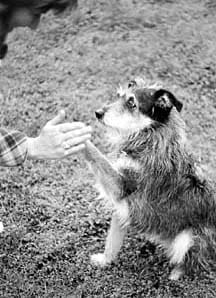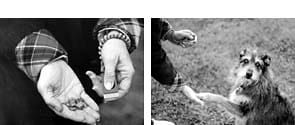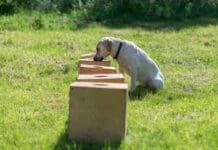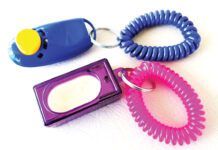Did you ever watch someone showing off his dog’s tricks? Sit up. Roll over. Jump through a hoop. Catch the ball. Balance a treat on Buddy’s nose. Shake paw. High five. Wave. And take a bow!
Did you happen to notice that it looked like human and canine were both having tremendous fun? No choke chains, no prong collars, no electric shock boxes. But lots of treats, toys, and lots of praise, smiles, and high-wagging tails.
Yet if you were to see that same dog and owner combination in a traditional compulsion-based training class you might well see frowns, a stern, commanding tone of voice, intimidating human body language, heavy metal around the dog’s neck, and a lot of appeasing body language signals from the dog – ears back, tail down, head lowered, averted glances, yawning, and nose licking. Why the difference?

We tend to think of basic behaviors such as sit, lie down, come and stay, as serious obedience. They are important, and Buddy has to do them in order to be a well-behaved dog. Tricks, on the other hand, are frivolous. It doesn’t really matter if Buddy rolls over when we ask him to. After all, it’s just for fun . . .
It’s all tricks!
Positive trainers have a saying that I love. We like to remind our clients that “It’s all tricks!” Teaching Buddy to sit when we ask him to is just as much a “trick” as teaching him to crawl on his belly across the living room rug. They are both simply behaviors that Buddy is physically capable of doing, that we teach him to offer us in response to a verbal cue or hand signal. If we can change our attitude and remember to have fun teaching the basics as well as the tricks, we can have a dog who performs the serious behaviors with just as much enthusiasm as he does when he rolls over or catches a treat off the end of his nose.
Chances are good that if you enroll in a positive training class, your instructor will incorporate tricks into each week’s lessons in order to keep the training process fun for everybody. You don’t have to wait for a training class to have more fun with Buddy – you can start anytime. All you need is your dog, a hefty supply of treats, a clicker, a few props, a quiet place to train without distractions, and a commitment to having fun. (Although you can use other reward markers besides the clicker – such as the verbal marker, “Yes!” – the clicker makes a constant, sharp, attention-catching sound that in most cases works better in the early learning stages than a verbal marker does. For best results, we suggest you try the clicker.) While you are teaching your dog tricks, take note of how much fun it is. Then remember to have just as much fun when you are teaching him those other, “serious” tricks like sit, down, stay, and come.
“Charging” the clicker
Although it helps if your dog already knows basic good manners, it’s not necessary for him to be fully obedience-trained in order to teach him tricks. If Buddy has not already been introduced to the clicker, we need to begin there. Start with the clicker in your pocket. The sharp Click! of the clicker startles some dogs. If you put it in your pocket at first it will muffle the sound until Buddy has a chance to associate it with the positive reinforcement of the treat. Once you are sure he is comfortable with the sound, you can hold it behind your back for a few clicks, then hold it in front of you to Click! and treat as you continue training. (If your dog seems unduly frightened of the clicker you can use the softer Click! of a ball-point pen, or just use a verbal “Yes!” as your reward marker.)
“Charging” the clicker, also known “conditioning the dog to the reward marker,” simply means teaching him that the Click! sound always means that a treat is coming. In order to charge the clicker, all you need to do is Click! the clicker, pause for a half-second, then feed Buddy a treat. He doesn’t have to do anything at all to get the Click! at this point, as long as he isn’t doing something you don’t want to encourage (such as jumping up on you). After six to 12 repetitions, most dogs begin to make the connection between the Click! sound and the treat. Now if you consistently Click! and treat every time he does a particular behavior, he will learn that he can make the Click! happen, just by sitting, which is exactly what we want. This part of the process generally takes less than 15 minutes. Once Buddy learns that he controls the Click!, he will offer behaviors in order to make the Click! happen, and you are ready to have fun with it.
Shake paw
There are several different ways to teach your dog to “Shake paw.” Some dogs are naturally “pawsy.” With these you can simply “capture” the behavior. Click! and treat when Buddy lifts his paw. Keep repeating the Click! and rewarding for a paw lift. When you see him deliberately offering a paw in order to win the reward, add the verbal cue “Shake!”, then Click! and treat. Hold out your own hand, palm up, as the hand signal for “Shake.” When you have repeated the verbal cue often enough that you think he has made the association, try asking for the behavior with just the word, without moving your hand. Give him a couple of seconds, and if he doesn’t offer his paw, offer your own hand to elicit the shake. If you keep repeating this sequence, Buddy will quickly learn to offer his paw for just the verbal cue.
If your dog is not a natural shaker you can “shape” the behavior by repeatedly clicking and rewarding any tiny lift of a paw off the ground. When Buddy is regularly lifting the paw slightly, start clicking only the more noticeable lifts. Gradually raise the criteria until he lifts the paw high enough for it to be considered a “Shake.” Then add the verbal cue as described above.
You may want to “lure” the paw lift. Some dogs will paw at your hand if you hold a treat in front of them in your closed fist; then you can Click! and treat. Others need still more help. Try holding a treat just over your dog’s head, then move it off to one side. Many dogs will lift a paw as they lean to follow the movement of the treat. Click! and reward. And repeat. If “capturing,” “shaping,” and “luring” don’t work, try “molding.” Touch the back of Buddy’s leg. If he lifts, Click! and treat. If a touch doesn’t work, you can actually lift the paw, Click! and reward. Just be aware that molding may teach Buddy to wait for you to touch him before he will shake. The other methods encourage him to think for himself and offer the behavior voluntarily, which is what we really want.
Once Buddy knows “Shake!” you can progress to “High Five” or “Wave” by clicking and rewarding simple variations on the theme. For example, for a “High Five,” offer your hand for a “Shake” but move it at the last minute into a High Five sign – palm toward Buddy, fingers pointed skyward.
Spin and twirl
This is a fun and easy trick than can be incorporated into your heeling for a flashy dance step. You can try shaping Buddy’s spin if you want (Click! and reward for a head turn, then gradually for greater and greater head and body turns, until he turns all the way around), but it’s usually easier and faster to lure it. I use the cue “Spin” for a counter-clockwise circle, and “Twirl” to mean clockwise. You can make them mean whatever direction you want or you can use entirely different words; just be consistent. One of my students does Musical Freestyle with her Great Dane. She uses “Donut” and “Cheerio” because you can say those words without moving your lips, and ideally, in Freestyle, you don’t want the judges to see your mouth move.
Have Buddy stand in front of you. If he wants to sit, back up while you ask him to spin. Let him see the treat in your right hand. Lure him in a circle to your right (his left) by moving the treat, at his nose level, in an arc toward his tail, then continue the circle with the treat until he is facing you again. When he has completed the circle, Click! and give him the treat. Repeat. When he is doing the circle easily, start saying “Spin,” first while he is turning, then just before. Gradually minimize the hand motion and eventually eliminate the lure, until he will spin on just the verbal cue, or with a tiny motion of your hand or finger. For “Twirl,” do the same thing, only start with the treat in your left hand and go the opposite direction. If Buddy is reluctant to do a complete circle at first, shape it. Click! and reward for partial turns, gradually increasing the arc until he will do a full circle.
Roll over
This one is a little more complicated. If your dog is already trained to “down” on cue, ask him to lie down. (Remember to Click! and reward him for that!) If he doesn’t already know how to “Down!”, wait until he lies down on his own, or lure him into a down by holding a treat in front of his nose when he is sitting, and then moving it slowly toward the floor. Keep clicking and rewarding him as he follows the treat toward the floor until he is all the way down.
Once your dog can lie down easily, encourage him to roll onto one side by moving the treat in an arc from his nose to a point just above his shoulder. Some dogs will do this easily the first trial, others need a little more encouragement through shaping – clicking and rewarding when the dog makes small moves in the right direction until he finally rolls onto one side. When he will roll onto one side for you smoothly, just keep going! Continue the arc of the treat lure so that he follows it with his nose and rolls his body all the way over. Where Buddy’s nose goes the rest of him must follow! Once your dog is doing one roll easily, try two in a row. Then more, until you can get him to do a whole series of roll overs.
Many dogs are one-sided, meaning they’ll roll easily in one direction but not the other. If your dog is having trouble with this trick, try rolling the opposite way. Then, once he has the easy direction figured out, make him ambi-pawstrous and shape the roll the other way as well.
Say your prayers
This is a fun trick that rates high on the cuteness scale. Have Buddy sit in front of a chair or stool that comes to about his mid-chest level. Lure him into lifting one or two front feet off the ground by raising the treat over his head, and then encourage him to rest his feet on the chair seat. You may need to Click! and reward for very short paw-rests at first, until he leaves his paws on the chair for longer and longer periods of time.
When he is sitting confidently with his paws resting on the chair for extended periods, lure his nose with a treat so he is looking down between his paws at the floor. Click! and treat. Once you know he will look between his legs without taking his paws off the chair, start using your verbal cue, “Say your prayers,” or “Meditate!” or whatever word or phrase you want to use. Gradually fade your use of obvious cues until he will run over to a chair, prop up his feet and “say his prayers” with just a verbal cue or hand signal.
Crawl
Buddy already knows “Down” from your Roll Over trick, so the crawl is easy to teach. It works best if you do it on carpet or grass – lots of dogs won’t crawl on a hard or rough surface. Ask Buddy to lie down facing you, and hold a treat in front of his nose. Keeping the treat just an inch or two above the ground, back up a step and very slowly move the treat toward you. As Buddy strains to follow the treat he should drag himself forward a tiny bit. Click! and reward. Keep repeating the sequence until he creeps farther and farther forward.
If the dog jumps up to follow the treat you may have moved it too far, or too fast. Slow down, and remember to Click! and reward tiny bits of the Crawl so Buddy can figure out how to do the right thing. The most common mistake most people make when training their dogs is trying to go too fast – asking for too much too soon. Ask for small behaviors so Buddy can win. As long as he keeps winning he will be more willing to keep trying.
Once Buddy is confidently crawling longer distances you can fade the lure and minimize the hand motion, and put the behavior on a verbal cue or a barely noticeable hand signal, as you did with the previous tricks.
Take a bow
You can end your routine with a flourish when you and Buddy take a bow together. Have Buddy standing in front of you or at your side. Put a treat in front of his nose, and move it toward his chest and down toward the floor. Here’s the tricky part. If you have taught him to lie down by moving a treat toward the ground, he may try to lie down here. Watch him closely. When he has a slight bend in his elbows, Click! and raise the treat so he stands up again, then reward. If you are slow, he will probably lie down; don’t Click! the Down. The quicker he lies down for you, the quicker you will need to be at clicking for his elbow bend and raising the treat up before he goes down. Gradually encourage Buddy to dip lower and lower until he can bow with his elbows touching the ground and his rear end high in the air.
When you are sure you can get a half-bow or better without having Buddy go all the way into a Down, you can start using the verbal cue. I suggest using something other than the word “Bow,” since “Bow” sounds a lot like “Down” and we are already risking confusion because of the similarity of the luring motion. One of my students uses the word “Bravo!”, which I like a lot. Others use “Take a bow,” with the emphasis on the word “Take” rather than “bow.”
Taking the show on the road
Now you have a repertoire of six tricks with which to dazzle your friends and neighbors. You can add an almost infinite number of new tricks simply by picturing the behavior in your mind that you want Buddy to perform, and then figuring out how to use your treats to lure, shape, capture or mold the behavior so you can Click! and reward it. Remember to break the behavior down into small pieces so Buddy can win at each step along the way to the final desired behavior.
Try it; you might like it! And once you are convinced that “It’s all tricks” you can toss those choke chains in the garbage and you and Buddy can get on with the serious business of having fun training together.
Pat Miller is a freelance author and a professional dog trainer in Fairplay, Maryland. She is author of many books on dog training.






